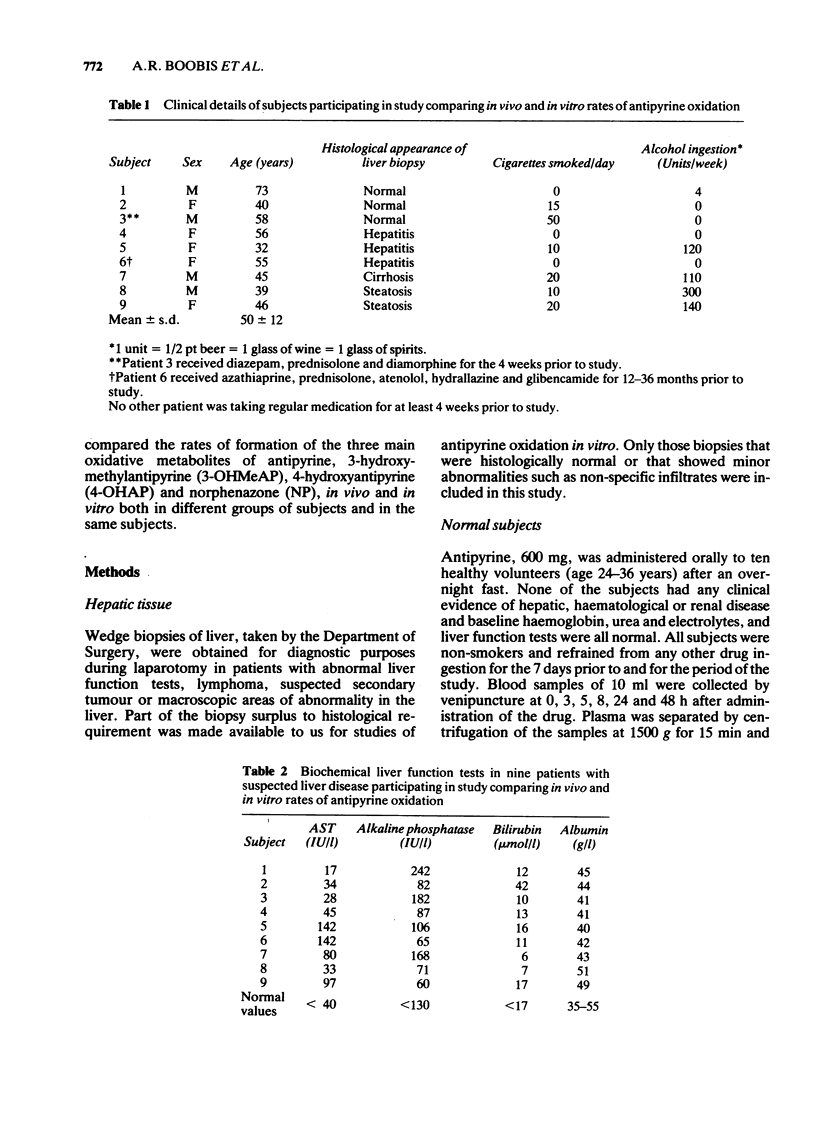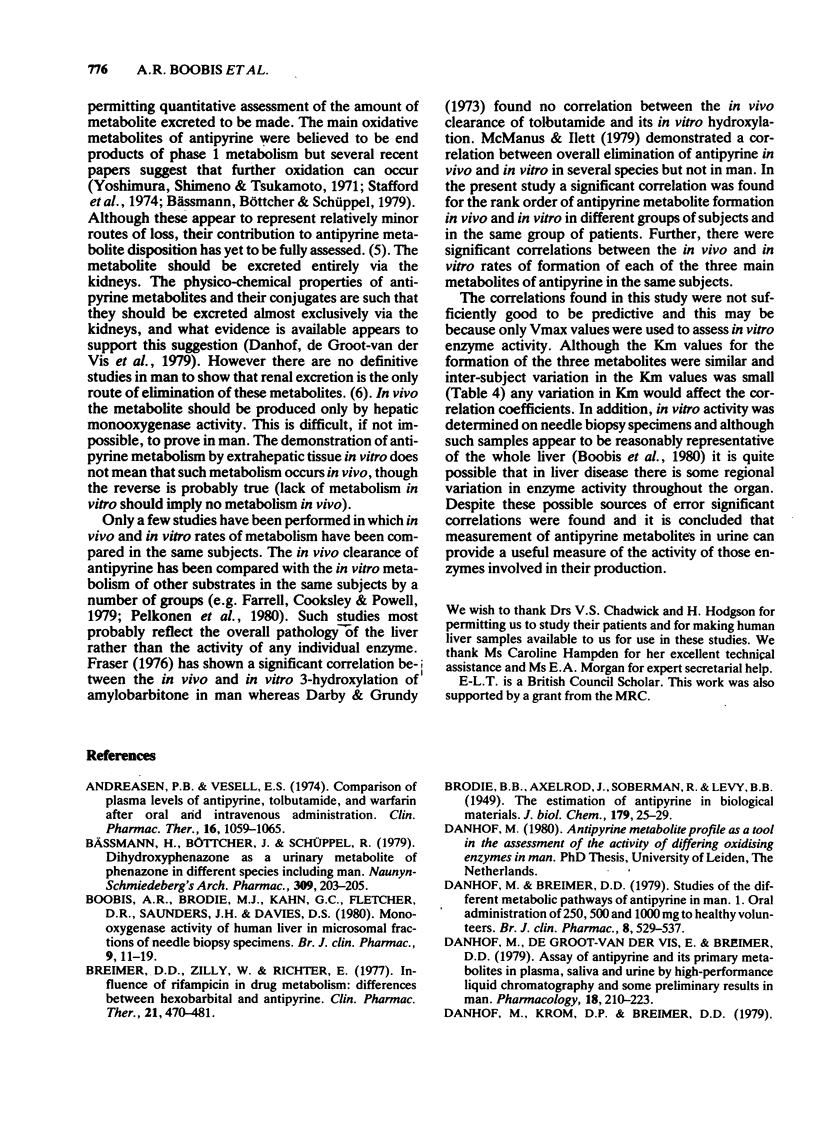Abstract
1 The metabolism of antipyrine to its three main oxidative metabolites, 4-hydroxyantipyrine, 3-hydroxymethylantipyrine and norphenazone was investigated in vivo and in vitro in separate groups of subjects with normal hepatic function and in the same group of patients with suspected liver disease. 2 The rank order for the rate of formation of the three metabolites of antipyrine was similar in vivo and in vitro. 3 There was no significant correlation between the rates of formation of any pair of antipyrine metabolites either in vivo or in vitro. 4 Despite this there was a significant correlation between the in vivo and in vitro rates for formation of each of the three metabolites in the same group of patients. 5 It is concluded that determination of rates of formation of antipyrine metabolites from their excretion in urine provides an indication of the activity of the enzymes involved in their formation.
Full text
PDF






Selected References
These references are in PubMed. This may not be the complete list of references from this article.
- Andreasen P. B., Vesell E. S. Comparison of plasma levels of antipyrine, tolbutamide, and warfarin after oral and intravenous administration. Clin Pharmacol Ther. 1974 Dec;16(6):1059–1065. doi: 10.1002/cpt19741661059. [DOI] [PubMed] [Google Scholar]
- Boobis A. R., Brodie M. J., Kahn G. C., Fletcher D. R., Saunders J. H., Davies D. S. Monooxygenase activity of human liver in microsomal fractions of needle biopsy specimens. Br J Clin Pharmacol. 1980 Jan;9(1):11–19. doi: 10.1111/j.1365-2125.1980.tb04790.x. [DOI] [PMC free article] [PubMed] [Google Scholar]
- Breimer D. D., Zilly W., Richter E. Influence of rifampicin on drug metabolism: differences between hexobarbital and antipyrine. Clin Pharmacol Ther. 1977 Apr;21(4):470–481. doi: 10.1002/cpt1977214470. [DOI] [PubMed] [Google Scholar]
- Bässmann H., Böttcher J., Schüppel R. 4,4'-Dihydroxyphenazone as an urinary metabolite of phenazone in different species including man. Naunyn Schmiedebergs Arch Pharmacol. 1979 Nov;309(2):203–205. doi: 10.1007/BF00501230. [DOI] [PubMed] [Google Scholar]
- Danhof M., Breimer D. D. Studies on the different metabolic pathways of antipyrine in man. I. Oral administration of 250, 500 and 1000 mg to healthy volunteers. Br J Clin Pharmacol. 1979 Dec;8(6):529–537. doi: 10.1111/j.1365-2125.1979.tb01040.x. [DOI] [PMC free article] [PubMed] [Google Scholar]
- Danhof M., Groot-van der Vis E., Breiner D. D. Assay of antipyrine and its primary metabolites in plasma, saliva and urine by high-performance liquid chromatography and some preliminary results in man. Pharmacology. 1979;18(4):210–223. doi: 10.1159/000137254. [DOI] [PubMed] [Google Scholar]
- Danhof M., Krom D. P., Breimer D. D. Studies on the different metabolic pathways of antipyrine in rats: influence of phenobarbital and 3-methylcholanthrene treatment. Xenobiotica. 1979 Nov;9(11):695–702. doi: 10.3109/00498257909042337. [DOI] [PubMed] [Google Scholar]
- Darby F. J., Grundy R. K. The metabolism of (ureyl-14C)tolbutamide in vitro and in vivo in man. Life Sci. 1973 Jul 16;13(2):97–105. doi: 10.1016/0024-3205(73)90184-7. [DOI] [PubMed] [Google Scholar]
- Farrell G. C., Cooksley W. G., Powell L. W. Drug metabolism in liver disease: activity of hepatic microsomal metabolizing enzymes. Clin Pharmacol Ther. 1979 Oct;26(4):483–492. doi: 10.1002/cpt1979264483. [DOI] [PubMed] [Google Scholar]
- Huffman D. H., Shoeman D. W., Azarnoff D. L. Correlation of the plasma elimination of antipyrine and the appearance of 4-hydroxy antipyrine in the urine of man. Biochem Pharmacol. 1974 Jan 15;23(2):197–201. doi: 10.1016/0006-2952(74)90410-9. [DOI] [PubMed] [Google Scholar]
- Huffman D. H., Shoeman D. W., Pentikäinen P., Azarnoff D. L. The effect of spironolactone on antipyrine metabolism in man. Pharmacology. 1973;10(6):338–344. doi: 10.1159/000136455. [DOI] [PubMed] [Google Scholar]
- Kahn G. C., Boobis A. R., Blair I., Brodie M. J., Davies D. S. Antipyrine as an in vitro probe of mixed function oxidase activity [proceeding]. Br J Clin Pharmacol. 1980 Mar;9(3):284P–284P. doi: 10.1111/j.1365-2125.1980.tb04844.x. [DOI] [PubMed] [Google Scholar]
- Kellermann G. H., Luyten-Kellermann M. Antipyrine metabolism in man. Life Sci. 1978 Dec 18;23(25):2485–2490. doi: 10.1016/0024-3205(78)90172-8. [DOI] [PubMed] [Google Scholar]
- LOWRY O. H., ROSEBROUGH N. J., FARR A. L., RANDALL R. J. Protein measurement with the Folin phenol reagent. J Biol Chem. 1951 Nov;193(1):265–275. [PubMed] [Google Scholar]
- Lu A. Y., West S. B. Multiplicity of mammalian microsomal cytochromes P-45. Pharmacol Rev. 1979 Dec;31(4):277–295. [PubMed] [Google Scholar]
- McManus M. E., Ilett K. F. Comparison of rate of hepatic metabolism in vitro and half-life for antipyrine in vivo in three species. Xenobiotica. 1979 Feb;9(2):107–118. doi: 10.3109/00498257909038711. [DOI] [PubMed] [Google Scholar]
- Murray S. An improved combined gas chromatographic mass spectrometric assay for the estimation of norphenazone in urine. Biomed Mass Spectrom. 1980 Apr;7(4):179–182. doi: 10.1002/bms.1200070409. [DOI] [PubMed] [Google Scholar]
- Pelkonen O., Sotaniemi E., Tokola O., Ahokas J. T. Correlations between cytochrome P-450 and oxidative metabolism of benzo[a]pyrene and 7-ethoxycoumarin in human liver in vitro and antipyrine elimination in vivo. Drug Metab Dispos. 1980 Jul-Aug;8(4):218–222. [PubMed] [Google Scholar]
- Prescott L. F., Adjepon-Yamoah K. K., Roberts E. Rapid gas-liquid chromatographic estimation of antipyrine in plasma. J Pharm Pharmacol. 1973 Mar;25(3):205–207. doi: 10.1111/j.2042-7158.1973.tb10625.x. [DOI] [PubMed] [Google Scholar]
- Stafford M., Kellermann G., Stillwell R. N., Horning M. G. Metabolism of antipyrine by the epoxide-diol pathway in the rat, guinea pig and human. Res Commun Chem Pathol Pharmacol. 1974 Aug;8(4):593–606. [PubMed] [Google Scholar]
- Vesell E. S., Page J. G. Genetic control of drug levels in man: antipyrine. Science. 1968 Jul 5;161(3836):72–73. doi: 10.1126/science.161.3836.72. [DOI] [PubMed] [Google Scholar]
- Vesell E. S., Page J. G. Genetic control of the phenobarbital-induced shortening of plasma antipyrine half-lives in man. J Clin Invest. 1969 Dec;48(12):2202–2209. doi: 10.1172/JCI106186. [DOI] [PMC free article] [PubMed] [Google Scholar]
- Vesell E. S. The antipyrine test in clinical pharmacology: conceptions and misconceptions. Clin Pharmacol Ther. 1979 Sep;26(3):275–286. doi: 10.1002/cpt1979263275. [DOI] [PubMed] [Google Scholar]


